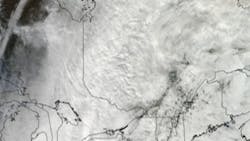Utilities Caught in the Crosshairs of Hurricane Sandy
A tropical depression in the western Caribbean caught the attention of meteorologists on Oct. 22, 2012. It quickly grew in strength and became Tropical Storm Sandy. Over the next week, the storm developed into Hurricane Sandy, leaving a path of death and destruction as it moved across the Caribbean into the Atlantic. About a week later, on Oct. 29, it slammed into the densely populated northeastern portion of the United States.
From the time it first formed until it made landfall, Sandy became the largest storm to ever hit the East Coast. It was more than 1,000 nautical miles, or 1,150 miles (1,850 km), wide — more than twice the size of the state of Texas. It impacted the North American Eastern Seaboard, from Florida to Nova Scotia and westward beyond the Appalachian Mountains to Wisconsin.
In all, Sandy affected more than 24 states plus the District of Columbia and several Canadian provinces. Being in the center of the storm's crosshairs, New Jersey, New York and Connecticut — an area with a population in excess of 60 million people — caught the brunt of the storm.
Devastated by a Hybrid
As far as storms go, Sandy delivered far more damage than most hurricanes, although the National Hurricane Center downgraded its status to a tropical cyclone shortly before it came ashore in the United State.
Sandy was a huge slow-moving storm. A week into restoration, an arctic storm called a nor'easter hit the U.S. It combined all the destruction of a hurricane with the devastation of a nor'easter, fueled by an arctic storm front. Sandy combined wind, rain, snow and flooding.
Sandy had a barometric pressure of 940 millibars, usually associated with Category 4 hurricanes. It also brought Category 1 hurricane winds of 90 mph (145 kmph) when it came ashore. In addition, storm surges were expected to reach 4 ft to 8 ft (1.2 m to 2.4 m) along the coast, with a predicted 11-ft (3.3-m) storm surge in northern New Jersey and Long Island. Meteorologists' estimates proved to be way too conservative.
The storm surge that hit New York City's Battery Park was measured at 13.88 ft (4.23 m). Storm surges of this magnitude are normally related to Category 4 storms, not tropical cyclones. The National Oceanic and Atmospheric Administration placed the destructive power of Sandy at 5.8 on a scale of 6. It seems like the National Hurricane Center and the National Oceanic and Atmospheric Administration should have gotten together on classifying this megastorm.
Standing By — But Not Idle
In the days prior to the superstorm's landfall, local officials prepared citizens for the storm and began to call for evacuation of coastal and low-lying areas. Likewise, utilities, manufacturers, contractors and suppliers were gearing up for the storm. Utilities activated their emergency-response plans, mobilized their employees, contacted their mutual assistance networks and battened down their systems.
The following pages track the restoration of five utilities that found themselves caught in the crosshairs of Superstorm Sandy: Long Island Power Authority, Con Edison, Public Service Electric and Gas Co., FirstEnergy's Jersey Central Power & Light and Connecticut Light & Power. Here are their stories.
Electric Outages by State
Note: States with fewer than 3,000 outages are not included in the table. Source: Outage numbers obtained from company websites and DOE communications.
Source: Outage numbers obtained from company websites and DOE communications.
About the Author
Rick Bush
Editorial Director
Richard A. Bush is the editorial director of Transmission & Distribution World. Prior to joining T&D World as editor-in-chief in 1994, Bush worked at the Georgia Power Company Research Center (now NEETRAC) where he held engineering and management positions.
In June 1988, Bush received the Georgia Power "Engineer of the Year" award, and in 1994, he received the "Technology Applications Recognition" award from the Electric Power Research Institute. In 1996, he was awarded a Jesse H. Neal Certificate of Merit for editorial excellence.
Bush holds BSME and MSME degrees from the Georgia Institute of Technology, and he is a senior member of the IEEE.
